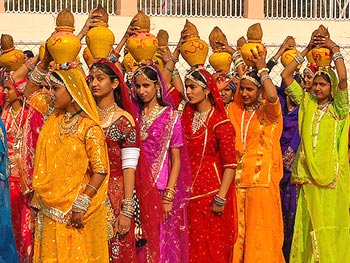
Most towns in Rajasthan have an annual festival to boast of, each enjoyable in their own way, but the one in Bikaner may be hard to beat.
If for nothing else then for the setting. The two-day Bikaner Camel Festival takes place in late December/ early January every year (This year the fair will be held on December 30 and 31, 2009), when the weather is just perfect to enjoy the festivities both during the day and in the evenings. While the first day of the event takes place at the Dr Karni Singh Stadium in the city, the magic begins when the action shifts to the little known village of Ladera, 45 km away.
What you witness is a kaleidoscopic display of Rajasthani culture and tradition. However, it is the setting that enhances the whole experience: a huge sand bowl, with clear skies, a bright moon above and the entire area resonating with the sounds of the festivities, far removed from the madding world we live in. As the compere said, "What you are seeing is pure real stuff, this is how people live and dress in Rajasthan. There is nothing artificial, not even the dresses."
There is no entry fee to the events, but food has to be paid for. You can make your own arrangements, or rely on those made by the local administration for transportation to Ladera.
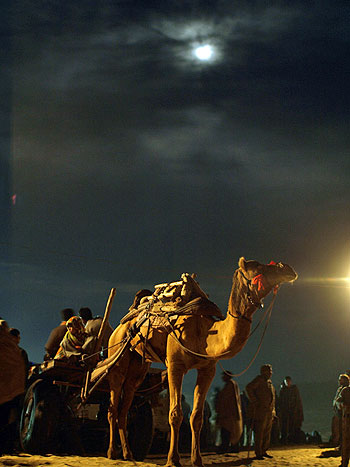
After parking the car at Ladera village, one has to cover a fair bit of ground to get to the actual venue of the performances. One can either walk through the sand dust blowing all over, or hop onto a camel cart. Just be careful not to sit too close to the camel; they tend to let it rip quite often.
The ride does not cost much -- Rs 20 one way
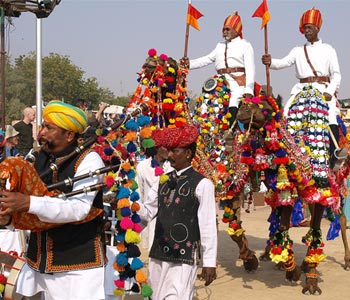
Rajasthan is proud of its valiant past, and it is only fitting for such events to remind the world of the same. "Rajasthan is known as the cradle of great warriors," announced the compere as the royal guards on beautifully decorated camels led the inaugural parade. These forces may only be symbolic now, but the riders still display the same pride as their predecessors may have when the elite camel corps, the Ganga Risala, existed and fought in the two World Wars.
The camels at the front are the ones belonging to the Sipasalhar, or the commander of the forces, distinguished with their lower legs specially adorned.
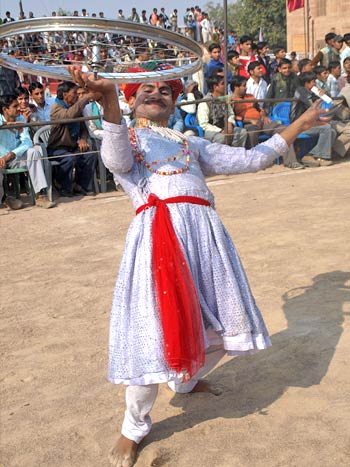
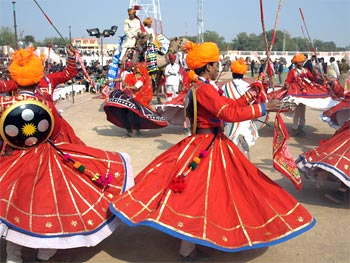
You never have to wait too long for Rajasthanis to break into a song and dance. With plenty of colour thrown in.
Sushil Mali brought his troupe to perform the Lal angi dandiya gir nritya dressed in all red. The only other time you would see the latter is at the Sheetla Saptmi fair during Holi around Barmer in West Rajasthan; there are a total of only 35-40 groups that perform this dance form and they all come together at this fair. They also get invited to cities like Jaipur and Jaisalmer to perform for tourists.

The stars of the festival had to be the camels, who else? And they sure surprise you with antics you would not associate with this species.
Take the acrobatics and dance competition for instance. Strutting, rolling on the ground, raising themselves high horse-style on just their hind legs, lifting money and tea kettles with their mouths to offer to the guests of honour and even taking their owner's neck it their mouth seemed like routine fare. Until you learn it takes six months to train them to do all this.
"Symphony between man and animal people are holding their breath seeing these stunts. What control, what posture," was how the compere shared his excitement with the audience present.
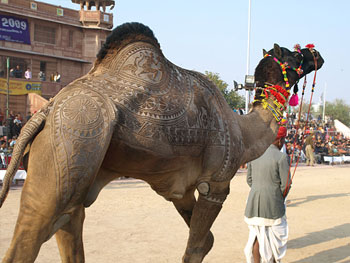
The artistry of Rajasthan was in full view when camels walked the 'ramp' with their fancy furs to decide the best of them all.
Camel fur is used for apparel and carpets, and also to give the animal an embroidered look when cut carefully on the body for the Baal Katra competition
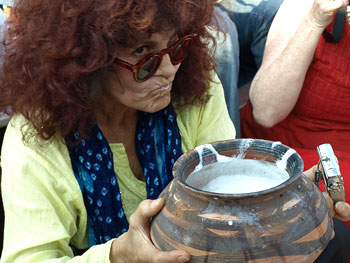
What followed was a treat -- of camel milk. Taken out fresh in the stadium in earthen pots, randomly selected visitors got sips of what is a slightly salty drink.
Locals, as well as the scientists at Bikaner's National Research Centre for Camels, believe this milk is highly nutritious and can also cure diabetes.
"Camel milk is beneficial, rich in protein you can use it to prepare coffee, ice cream and many drinks. Milking of cow is a common sight, but you may be witnessing the milking of a female camel for the first time," raved the compere. It was a sight all right, with some men holding her by tail to keep her steady while being milked.

"Rajasthan is known as the cradle of great warriors," is how the compere announced the start of the Mr Bikaner competition at the fair.
All the dozen odd competitors may not have been battle ready but they sure dressed like they were. With beards and moustaches, trying to look more macho than the others, they looked quite striking in their turbans, traditional clothes and silver and metal jewellery.
They tried to look mean while brandishing their swords, but their smiling faces betrayed their gentle personalities. Of course, when they thought the eyes of the judges were on them or the cameras were pointed in their direction, they did try to nudge and jostle their neighbour away to garner all the attention.

But the real 'man' who got the bride was a six year old, who won the heart of a five year old. Wherever the 'groom' went, the 'bride' followed a few steps behind with her head bowed. Dressed like any elder would have, they sure made for a beautiful couple.
And not to be missed was the man in the yellow turban, Jagdish Purohit. With a respectful title of Hemsa, he was the principal choreographer of the entire show blowing his whistle to keep everyone in line. He also led the 'young couple' to the event as seen in the image here.
The real test for men comes at Ladera when they all face off over Gramin Kusti (rural wrestling), Kabaddi, dune racing, camel racing and kho kho. Women jump in with musical chairs. And the way everyone was being cheered and rooted by local supporters, it looked like some world championships were underway.
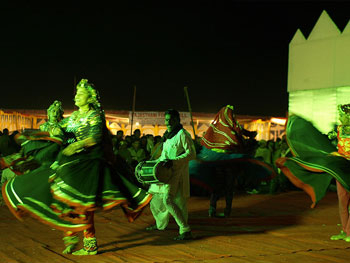
It gets better when you see the performances at night in Ladera. "The night is getting cooler and cooler and the stage is getting hotter and hotter," announced the compere. Winning the hearts was a woman dancing solo to the evergreen Pallu latke song; before emissaries of love could come running to the stage, the compere announced, "If you heart has come upon this dancer, may I tell you she is a man!"
There were six women performing the famous Ghoomar dance, enacting a scene where they are asking their mother for permission to go out and dance. Janki Lal and Party pumped in a lot energy beating their drum and playing other instruments; this was their first time at Bikaner after performing in Europe many times. "It is the finest music group in these neck of the woods," announced the compere in the middle of a landscape where not a blade of grass grew for miles.
And for three days you are treated to the wide swathe of Rajasthani culture. The performers may be amateurs in many cases, but they made for far better entertainment than many a professionals could.

A surprise element at the Bikaner Camel Festival were dances by a group of eunuchs dressed in bright colours of red, magenta and yellow wearing heavy make-up.
Traditionally eunuchs come calling upon Indian homes on the occasion of childbirth, marriages and even house warming and inauguration of a new office. They sing and dance to mark these occasions, for gifts and money in return. With changing times these practices may have been on the decline but they are still a common sight.
They danced during the inaugural parade and on stage again; some of the movements were sexually suggestive in nature. But meeting them backstage revealed a far more modest side of these performers.
They kept their faces covered with the veil of their dresses and were not the types who go from house to house to earn their daily bread. Raju Gori, and two others, work as office boys in various government departments. Sunil, dressed in yellow, is taking computer literacy classes to enhance his professional prospects. "They all get called upon by the authorities to perform at festivals like these after which they go back to work", disclosed Narayan Singh.

No occasion in Rajasthan can be complete without food, the kind to spoil you for choice and taste. Same goes for the Bikaner festival.
You can try the best tasting samosas imaginable freshly prepared at a stall run by the Armed Forces. Yes, being close to the border with Pakistan has its perks. Or go for multiple rounds of pakoris, made by deep frying a mix of vegetables and gramflour, drowned with sweetened tea.
And then comes the cherry on the cream: a dinner (if you still have some room left for it) of authentic Rajasthani dishes including Daal, Baati, Choorma, Gatte ki Subzi and more. Those serving said this was cooked exactly as they eat at home; the stall had been set up only because the local administration had asked them to. Those managing it are farmers otherwise.
Trust me when I say this: no restaurant or cook in the world can beat it. I had to stop only because it was embarrassing to eat so much; you cannot overextend the invitation for eat-all-you-can at Rs 100. Especially when each helping is personally served to you at your table. When I offered a tip of a hundred rupees, one of the elders respectfully declined to accept it with folded hands. They were here only to serve us, 'no tips please' he said.
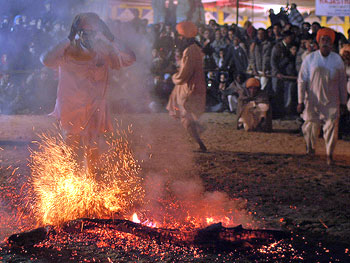
The 'hottest' and much awaited event was the fire dance. It is performed by members of the Sidh community who are supposed to have been blessed with special powers by Sant Jasnath ji.
These dancers take turns to walk on a bed of burning wood and coal, and dance around the fire. A few of them even take in pieces of burning coal in their mouths letting out sparks. All seemingly under a spell of the soft drug bhaang made from the leaf of cannabis indica. Theories abound on how these dancers pull off this 'trick,' but does one care? The thrills were complete.
How to get there
Bikaner is about 456 km away from Delhi and 330 km away from Jaipur. It takes about 8 hours fro Delhi and about 5 hours fro Jaipur on an excellent highway by road.
Closest airports are at Jodhpur (about 254 km away) Jaipur and Delhi. You can even take a train from Delhi (Bikaner Mail).
Where to stay
There is no dearth of accommodation options ranging from low priced guest houses to luxury hotels. Some key options include:
Laxmi Niwas Palace: A luxury heritage hotel. Tariff: Rs 7,500 to 20,000 per night.
Bhanwar Niwas: An excellent property, a former haveli, run by the owners. Tariff Rs 4,000 to 12,000 per night.
Raj Vilas Palace: One of the newer heritage hotels. Tariff: Rs 2,200 to 6,600 per night.
RTDC Dholamaru Hotel: A budget hotel run by Rajasthan Tourism. Tariff: Rs 990 to 2,000 per night.
Ajay Jain is a travel author and photographer, and blogs on travel at www.kunzum.com. His latest book is 'Postcards from Ladakh,' a pictorial travelogue on Ladakh. He can be contacted at ajay@ajayjain.com.